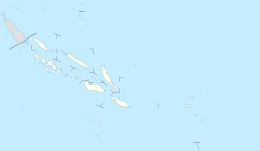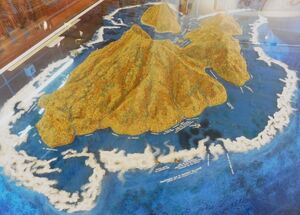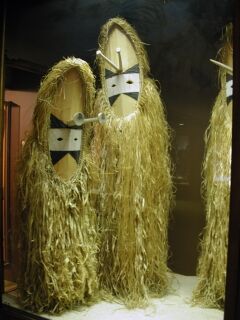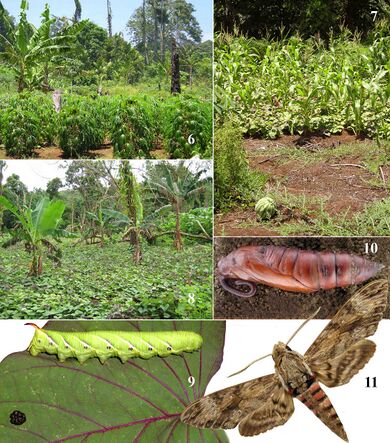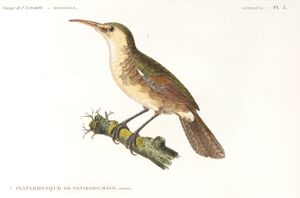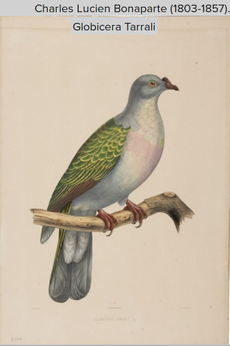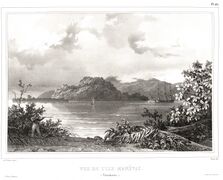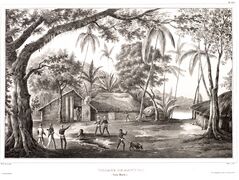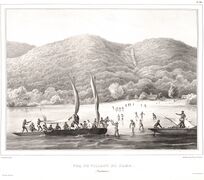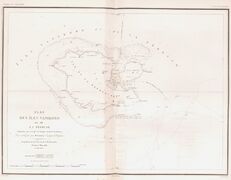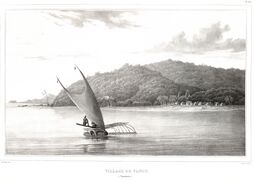ڤانيكورو
الاسم الأصلي: Vanikoro | |
|---|---|
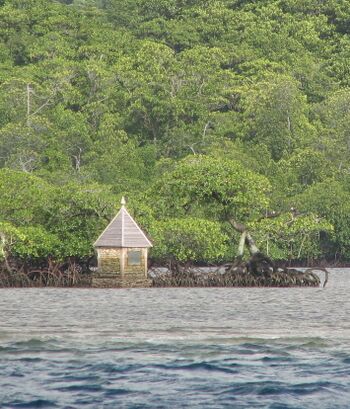 النصب التذكاري لـ لا پيروز في ڤانيكورو | |
| الجغرافيا | |
| الإحداثيات | 11°39′S 166°54′E / 11.650°S 166.900°E |
| الأرخبيل | جزر سانتا كروز |
| المساحة | 173 km2 (67 sq mi) |
| الإدارة | |
جزر سليمان | |
| المقاطعة | Temotu |
| السكان | |
| التعداد | 1293 (2009) |
| الجماعات العرقية | Melanesian, Polynesian |
Vanikoro (sometimes wrongly named Vanikolo) is an island in the Santa Cruz group, located 118 كيلومتر (73 ميل) to the Southeast of the main Santa Cruz group. It is part of the Temotu Province of the Solomon Islands.
The name Vanikoro is always used as though it referred to a single island, due to both its geophysical and cultural unity. However, technically it is a group of several nearby islands surrounded by a single belt of coral reef. Only the two major islands are inhabited: the bigger one Banie, and the smaller one Teanu (or Tevai). Other, uninhabited islets in the Vanikoro group include Manieve, Nomianu and Nanunga. The total area of the Vanikoro group is 173 متر كيلومربع (66.8 ميل مربع).
الجغرافيا
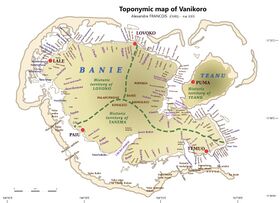
Vanikoro is part of the small archipelago known traditionally as Santa Cruz , today often named "Temotu", after the official name of the easternmost province of the Republic of the Solomon Islands. Vanikoro lies very far from the main Solomon Island chain , and much closer geographically to the northern islands of Vanuatu 3 .
It is made up of two main islands:
Banie , the main island, with an area of more than 193 km2 ; the highest point, Mount Banie, is an ancient volcano. Teanu or Tevai , his little neighbor; and two small islets:
Nanunga, and the Manevai peninsula. The two islands are surrounded by coral reefs , a first about 2 km wide then a second against the beaches and, between the two, a lagoon in which six passes can be used by small vessels 4 .
The highest of the mountains, Kopago, almost 1,000 meters above sea level, is covered with thick forests; several streams provide abundant water.
The presence of tabular mounds of ancient soil with numerous tree ferns , approximately one meter above the current soil, clearly shows the sinking of the island by subsidence 5 .
السكان واللغات
The 1,293 inhabitants of Vanikoro[2] consist of two different populations, who tend to live separately.
The Melanesian majority, about 800 people, are the descendants of the original population of Vanikoro. As far as we know, they have been present on the island since Lapita times – about 3,200 years ago.
A minority of about 500 individuals are of Polynesian descent: they have migrated from the island of Tikopia, an island lying 200 كيلومتر (124 ميل) eastwards, which they identify as their origin. They established their first settlements on Vanikoro about 400 years ago on the southern coast of Banie. In 1893, many Tikopians returned to Tikopia as a result of the Solomon Islands having been declared a British protectorate.; but several Tikopians returned to Vanikoro in the 1900s. The two major villages are Murivai and Taumako Bay.
The three languages spoken by the Melanesian population of Vanikoro are all Oceanic, of the Temotu subgroup:[3]
The Tikopian settlers speak a Polynesian language, Tikopian or fakatikopia.
التاريخ
The first sighting of Vanikoro by Europeans was in September 1595, by the second Spanish expedition of Álvaro de Mendaña. It was sighted by Lorenzo Barreto, while in command of one of the smaller vessels on a voyage around the then Santa Cruz, which is today's Nendo Island.[4][5]
The French explorer Jean-François de La Pérouse was stranded on Vanikoro after both his vessels, La Boussole and the Astrolabe, struck the then unknown reefs of the island in 1788. It is reported[6] that some of the men were killed by the local inhabitants, while the surviving sailors built a smaller vessel and left the island, but were never seen again. Those that remained on the island died before search parties arrived in 1826. Jules Verne dedicates a chapter of his novel Twenty Thousand Leagues Under the Sea to this event.[7] Author Naomi Williams' novel Landfalls explores the Lapérouse expedition in depth.[8]
Chapter 1, Coral Sea, of James Michener's novel, Tales of the South Pacific, is set on the island of Vanicoro.
النبيت والوحيش
Vanikoro is largely forested, with an annual rainfall of 5,000 mm. Most of its human population is engaged in subsistence farming. It has been identified by BirdLife International as an Important Bird Area (IBA) because it supports populations of endemic Vanikoro monarchs and Vanikoro white-eyes, as well as of red-bellied fruit doves, pied goshawks, palm lorikeets, cardinal myzomelas, Polynesian trillers and rusty-winged starlings.[9] The Vanikoro flying fox is endemic to the island.
علم الحشرات
A CIRAD entomologist participated in two campaigns organized by Alain Conan , that of 2003 and that of 2005 6 . The objective he set in response to the request of Yves Bourgeois, director of the Thalassa films devoted to these expeditions, was, by contributing to the inventory of the island's insect biodiversity , to make relive in the field “the breath, the spirit and the way of working of the naturalists of the Lapérouse expedition,” who had purchased cork plates and insect pins in 1785 for this expedition.
His observations regarding the negligible damage caused by insects in the coastal food gardens are encouraging: "The proximity of the forest, the absence of intensive monoculture, the obvious preservation of the natural balance, mean that the Potential pests are naturally controlled by their natural enemies: predatory insects and parasitoids, nematodes , fungi, bacteria, viruses, etc. »
The census is currently being carried out and allows us to draw some conclusions of a biogeographical nature in a regional group which goes from the Indian Ocean to the Pacific Ocean, because the insects of the island were all imported, "by marine currents on floating rafts of trunks or plant debris, by winds or cyclones, or more recently by men. » The Vanikoro fauna is part of the Australian region but also includes elements present in the eastern region.
The entomofauna of Vanikoro is of a typically island character, relatively poor in species and unbalanced in its composition (certain groups are absent or represented by few species), with a few endemic species, this because of the small dimensions of the island, its distance from richly populated lands and its recent age (around 5 million years).
Various levels of endemism are observed in Vanikoro:
- species specific to the Solomon Islands: beetles and stick insects;
- butterflies from the Santa Cruz Islands (archipelago to which Vanikoro belongs): Lycaenidae , Euploea and Nymphalidae ;
- وأخيراً، strictly endemic species of Vanikoro: the Lapérouse Cicada (discovered by HP Aberlenc in 2003): Baeturia laperousei Boulard, 2005 and several species of beetles (Histeridae, Staphylinidae Pselaphinae, Passalidae, Cerambycidae or Longicornes, Curculionidae).
As Henri-Pierre Aberlenc points out, “this endemism implies a strategy for defending biodiversity: it is important to preserve areas in good condition on as many islands as possible. »
Three new species of Histeridae beetles , including one endemic and new to science (Tribalus folliardi Gomy & Aberlenc, 2006, dedicated to Jean-Pierre Folliard, one of the members of the expedition) were found and studied upon return from the last expedition 7 .
The cymbalization (which is incorrectly called the "song") of Lapérouse's cicada was recorded in 2005 at the request of Henri-Pierre Aberlenc by the sound recordist for Yves Bourgeois' film team, Michel Faure 8 and studied by Michel Boulard of the National Museum of Natural History . He was able to compare them with his recordings of the Uvea cicada , the largest of the Wallis Islands in 1996. He established the Acoustic Identity Maps of these two species, morphologically very similar but producing significantly different cymbalizations as proven analysis of sonograms . The acoustic behavior thus confirmed the distinction between the two species, which had initially only been separated on the basis of morphological characters.
الطيور
According to the observations of Dumont d'Urville, the island of Vanikoro has few birds: three species of doves – oceanic, turvert (Chalcophaps indica) and a variety of the Kurukuru (Columba purpurata) which is distinguished by liveliness of its colors and the purple of its belly) – a blackbird holding anteaters, and the black-headed sultana hen. Also observed were the red and gray sunbird , a kingfisher , the swallow , the platyrhynchus (πλατυ-ρρυγχος "wide-billed") of Vanikoro, the fan-tailed flycatcher and the red and black treecreeper (the latter two are also in the Mariana Islands) 9 . The National Museum of Natural History has a Ptilopus greyi described by Charles-Lucien Bonaparte in 1857 “reported since 1829 from the island of Vanikoro to the Museum by L'Astrolabe” 10 .
The Vanikoro monarch is an endemic species that has adapted well to human disturbance to its forest habitat.
معرض رسوم دومون دورڤيل
ملاحظات
- ^ Source: Maps of Vanikoro (languages, place names) by linguist A. François.
- ^ "Vanikoro (Ward, Solomon Islands) - Population Statistics, Charts, Map and Location". www.citypopulation.de. Archived from the original on 2021-07-09. Retrieved 2021-07-09.
- ^ François, Alexandre (2009), "The languages of Vanikoro: Three lexicons and one grammar", in Evans, Bethwyn, Discovering history through language: Papers in honour of Malcolm Ross, Pacific Linguistics 605, Canberra: Australian National University, pp. 103–126.
- ^ Sharp, Andrew The discovery of the Pacific Islands Oxford, 1960, pp.52-55.
- ^ Brand, Donald D. The Pacific Basin: A History of its Geographical Explorations The American Geographical Society, New York, 1967, p.136.
- ^ See summary article in The Times, May 13, 2005.
- ^ Verne, Jules (1992). Twenty Thousand Leagues Under the Sea. Hertfordshire: Wordsworth Classics. pp. 81–85.
- ^ Naomi, Williams (19 December 2014). "Landfalls". naomijwilliams.com. Farrar, Straus and Giroux. Retrieved 27 April 2017.
- ^ "Vanikoro". BirdLife Data Zone. BirdLife International. Retrieved 8 October 2020.
المراجع
- Vanikoro Island (archived link)
- Resources on the languages of Vanikoro (introduction to the dictionary of Teanu), by linguist A. François.
